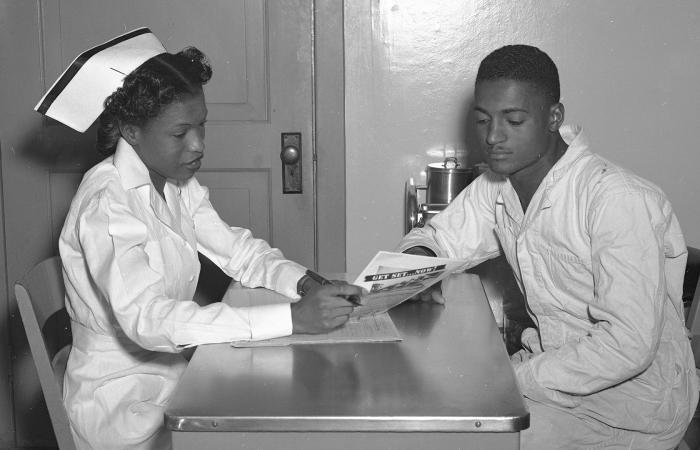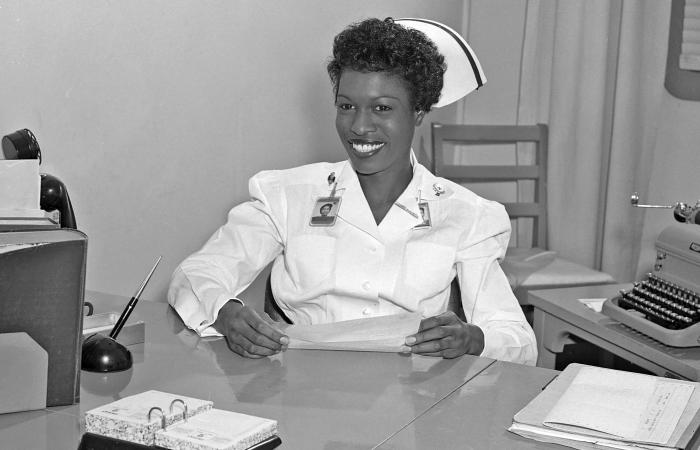-

President Harry Truman selected ORNL nurse Doris Scott to serve on the Industrial Health Section of the President's Commission for Health. The committee's purpose was to inventory and study national health needs and related education. Credit: ORNL
-

ORNL nurse Doris Scott's job was to orient new hires to the Lab's health services. Credit: ORNL
-

President Harry Truman selected ORNL nurse Doris Scott to serve on the Industrial Health Section of the President's Commission for Health. The committee's purpose was to inventory and study national health needs and related education. Credit: ORNL
-

ORNL nurse Doris Scott's job was to orient new hires to the Lab's health services. Credit: ORNL
When in 1948 Doris Belle Scott, just graduated from Meharry Medical College School of Nursing, sat for her interview for a position at Oak Ridge National Laboratory, the medical director, J.S. Felton, explained the Laboratory's philosophy of industrial health: "That the maintenance of a worker's health is as important after the whistle blows as before, and that every employee, irrespective of his or her position on the staff, is indispensable in accomplishing the mission of the staff."
Scott was interviewing for a nursing job in the fledgling research laboratory's Health Division. Likely contributing to any job interview jitters was the fact she was a Black woman seeking a professional position in the Jim Crow South, a reality she acknowledged in a 1952 article published in the American Journal of Nursing:
A casual observer might think that a Negro nurse could have any available position for which she qualified in this unique town. But such is not the case. The town is new, yes, and there are no traditions. But the old patterns of segregation and discrimination are the same. However, because of a large number of highly trained, liberal employees at the laboratory that have come from other sections of the country, the objections to the employment of a Negro nurse on an unsegregated basis are less formidable than they would be in most Southern towns.
As she noted, Oak Ridge's more cosmopolitan and highly educated population may have been more accepting of a Black woman than most Tennessee towns and workplaces. Scott's actual experience at ORNL was more of a mixed bag. She saw acceptance and also prejudice.
Scott reported she encountered no discriminatory attitude among the Health Division staff. Among patients, the "highly trained personnel whom I cared for often displayed a feeling of warmth." Some white employees "seemed amazed" at her nursing skills. Others wanted nothing to do with her and were provided with white nurses.
Her descriptions of her experiences at ORNL were published soon after she arrived at ORNL, in the publications Industrial Nursing and National Negro Health News, and ultimately in the 1952 AJN article. On one occasion she was asked "where I had learned to write so well!"
At the Lab, Scott oriented newly hired Black employees to its health services and carried out special health programs. She led the planning for National Negro Health Week and joined an effort with the local union to improve living accommodations for African American workers.
A meningitis outbreak in the late 1940s hit Oak Ridge's Black community particularly hard. Scott worked with local agencies and the Oak Ridge hospital to share health information with local Black families. A blood screening event she helped organize with the local Citizens Health Committee made up of African American citizens drew 1,500 participants.
"The need for health education in the Negro community was obvious to these groups, and they readily agreed to help in any way that they could," Scott wrote.
President Harry Truman, perhaps prompted by the AJN article, in 1952 appointed Scott to serve on the Industrial Health Section of the President's Committee for Health, one of just 10 professionals invited to join the panel.
Scott, a native of Gainesville, Ga., lived in Knoxville and according to her employment record also had a connection to Knoxville College, a historically Black school. She did her pioneering work at ORNL until 1955.
ORNL, which during Scott's time was under the mantle of the Atomic Energy Commission, is now the Department of Energy's largest energy research laboratory.






